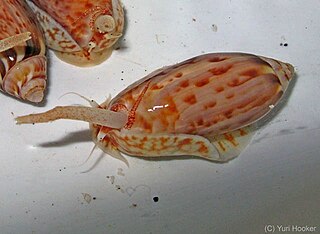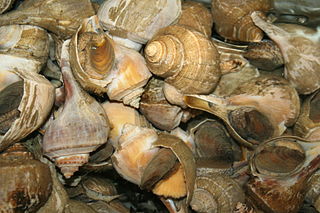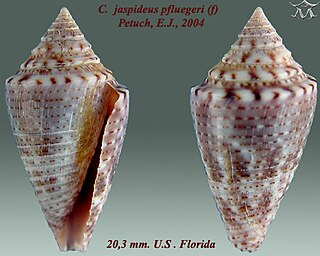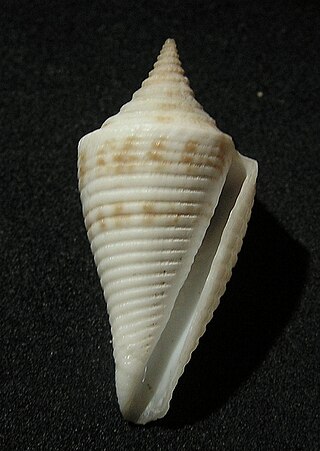
Busycon is a genus of very large edible sea snails in the subfamily Busyconinae. These snails are commonly known in the United States as whelks or Busycon whelks. Less commonly they are loosely, and somewhat misleadingly, called "conchs".

Olive snails, also known as olive shells and olives, scientific name Olividae, are a taxonomic family of medium to large predatory sea snails with smooth, shiny, elongated oval-shaped shells.

The Buccinidae are a very large and diverse taxonomic family of large sea snails, often known as whelks or true whelks.

Sinistrofulgur perversum, the lightning whelk, is a species of very large predatory sea snail or whelk, a marine gastropod mollusc in the family Busyconidae, the busycon whelks. This species has a left-handed or sinistral shell. It eats mostly bivalves.

The Melongenidae, the crown conchs and their relatives, are a taxonomic family of large to very large marine gastropods in the superfamily Buccinoidea.

Sinistrofulgur contrarium is a fossil snail species of the busycon whelks in the family Busyconidae. There has been some confusion about the correct taxonomy of this species, which has been confused with the extant species Sinistrofulgur sinistrum Hollister, 1958, and Sinistrofulgur perversum

Busycotypus is a genus of very large sea snails, marine gastropod mollusks in the subfamily Busycotypinae.

Cassis, common name the helmet shells, is a genus of very large sea snails, marine gastropod mollusks in the family Cassidae, the helmet shells and their allies. This is the type genus of the subfamily Cassinae.

Fulguropsis is a genus of sea snails, marine gastropod molluscs in the family Busyconidae, the crown conches and their allies.

Jaspidiconus is a subgenus of sea snails, marine gastropod mollusks in the genus Conasprella, family Conidae, the cone snails and their allies.

Phyllonotus is a genus of medium to large sized predatory sea snails. These are carnivorous marine gastropod molluscs in the family Muricidae, the murexes or rock snails.

Conasprella is a genus of sea snails, marine gastropod mollusks in the family Conidae, the cone snails and their allies. This genus was formerly treated by some experts as a member of the family Conilithidae and as an "alternative representation" of this group of species.

Cinctura is a genus of fasciolariid sea snails known as the banded tulip shells. Species in this genus were previously grouped in the closely related genus Fasciolaria.
Conasprella berschaueri is a species of sea snail, a marine gastropod mollusc in the family Conidae, the cone snails, cone shells or cones.

Sinistrofulgur is a genus of large sea snails with left-handed shell-coiling, marine gastropod mollusks in the subfamily Busyconinae.

Sinistrofulgur sinistrum is an edible species of large predatory sea snail in the family Busyconidae, the busycon whelks. This species is often confused with Sinistrofulgur perversum, and with Busycon contrarium, which is now considered an exclusively fossil species.

Morum is a genus of sea snails, marine gastropod mollusks in the subfamily Moruminae of the family Harpidae.

The Busyconidae are taxonomic family of large sea snails, often known as whelks.

Fulguropsis spirata, commonly known as pear whelk, is a species of sea snail, a marine gastropod mollusk in the family Busyconidae, the busycon whelks. The species is also occasionally referred to as the Gulf pear whelk to differentiate it from other Fulguropsis species which are also referred to as pear whelks. It is an edible mollusc found in areas from the Caribbean to the Western Gulf of Mexico. The species was previously thought to range through the entire Gulf of Mexico down the Florida Peninsula and as far north as North Carolina in the Atlantic. The species is generally not found East of the Mississippi Delta, and any Fulguropsis found Eastward from said delta are most likely of the species Fulguropsis pyruloides. As a result many records of F. pyruloides from the aforementioned regions are falsely labelled as F. spirata.
Fulguropsis pyruloides is a species of Marine Gastropod, commonly known as the pear whelk. It is also known as the Florida pear whelk or Atlantic pear whelk in scientific and shelling circles to differentiate from the more well known Fulguropsis spirata, which is also known as the Pear Whelk. It was first described by American conchologist, Thomas Say, in 1822.

















